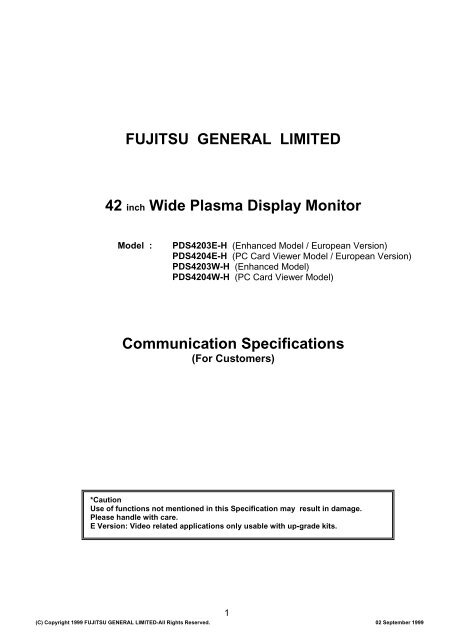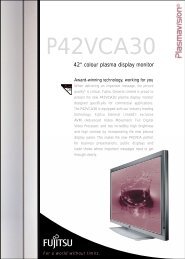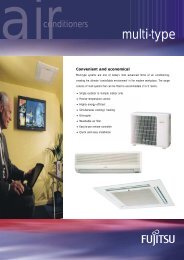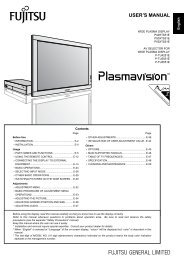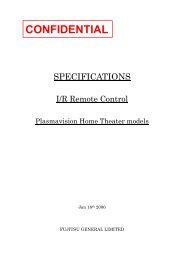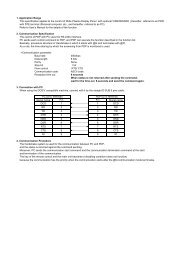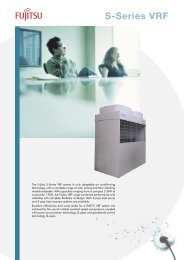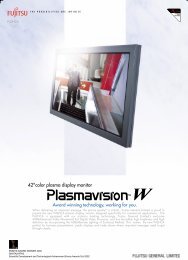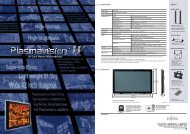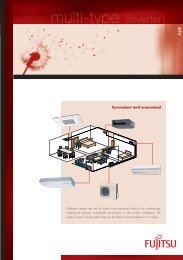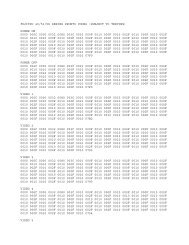PDS4203-04 RS232 Protocol.pdf - Fujitsu General UK
PDS4203-04 RS232 Protocol.pdf - Fujitsu General UK
PDS4203-04 RS232 Protocol.pdf - Fujitsu General UK
You also want an ePaper? Increase the reach of your titles
YUMPU automatically turns print PDFs into web optimized ePapers that Google loves.
FUJITSU GENERAL LIMITED<br />
42 inch Wide Plasma Display Monitor<br />
Model : <strong>PDS4203</strong>E-H (Enhanced Model / European Version)<br />
PDS42<strong>04</strong>E-H (PC Card Viewer Model / European Version)<br />
<strong>PDS4203</strong>W-H (Enhanced Model)<br />
PDS42<strong>04</strong>W-H (PC Card Viewer Model)<br />
Communication Specifications<br />
(For Customers)<br />
*Caution<br />
Use of functions not mentioned in this Specification may result in damage.<br />
Please handle with care.<br />
E Version: Video related applications only usable with up-grade kits.<br />
1<br />
(C) Copyright 1999 FUJITSU GENERAL LIMITED-All Rights Reserved. 02 September 1999
Contents<br />
1. RANGE OF APPLICATION..................................................................................................................................................3<br />
2. COMMUNICATION SPECIFICATION ..............................................................................................................................3<br />
3. PC CONNECTION..................................................................................................................................................................3<br />
4. COMMUNICATION PROCEDURE.....................................................................................................................................3<br />
5. EXAMPLE OF PROTOCOL .................................................................................................................................................4<br />
6. LIST OF COMMANDS...........................................................................................................................................................5<br />
7. EXPLANATION OF COMMANDS ......................................................................................................................................6<br />
7-1 COMMUNICATION CONTROL..................................................................................................................................................6<br />
7-1-1 Connection Commands ...................................................................................................................................................6<br />
7-2 SYSTEM CONTROL ..................................................................................................................................................................6<br />
7-2-1 Power Supply ON ............................................................................................................................................................6<br />
7-2-2 Power Supply OFF ..........................................................................................................................................................6<br />
7-2-3 Video ON..........................................................................................................................................................................7<br />
7-2-4 RGB ON...........................................................................................................................................................................7<br />
7-2-5 S-Video ON ......................................................................................................................................................................7<br />
7-2-6 Component Video AUTO input ON ................................................................................................................................7<br />
7-2-7 PC Card ON.....................................................................................................................................................................7<br />
7-2-8 PC Card AUTO................................................................................................................................................................7<br />
7-2-9 PC Card MANUAL..........................................................................................................................................................7<br />
7-2-10 PC Card RESET ............................................................................................................................................................7<br />
7-2-11 PC Card FORWARD.....................................................................................................................................................8<br />
7-2-12 PC Card REVERSE.......................................................................................................................................................8<br />
7-2-13 Remote Control and Main Body Key Use .....................................................................................................................8<br />
7-2-14 Current Status Report....................................................................................................................................................8<br />
7-2-15 Display Control Command............................................................................................................................................9<br />
7-2-16 LED Control Command ................................................................................................................................................9<br />
7-2-17 Aspect Command ...........................................................................................................................................................9<br />
7-2-18 Speaker Volume Command.........................................................................................................................................10<br />
7-2-19 Video Mode Command ................................................................................................................................................10<br />
7-2-20 Transition of Mode (with check sum) .........................................................................................................................10<br />
7-2-21 Transition of Mode (without check sum)....................................................................................................................10<br />
7-2-22 Termination of Communication..................................................................................................................................10<br />
2<br />
(C) Copyright 1999 FUJITSU GENERAL LIMITED-All Rights Reserved. 02 September 1999
1. Range of Application<br />
This specification applies to the control of the 42inch Wide Plasma Display Monitor by connection to the PC.<br />
(Hereafter referred to as PDP monitor)<br />
2. Communication Specification<br />
The control command from the Personal Computer is issued through the RS-232C interface by connecting the<br />
PDP monitor and the personal computer through the RS-232C cable.<br />
-Communication Parameter<br />
Baud Rate<br />
Data Length<br />
Parity<br />
Stop Bit<br />
Flow control<br />
Communication Code<br />
3. PC Connection<br />
The PDP is connected to an IBM compatible PC with a straight cable D-sub 9 pin.<br />
(Enhanced model/PC Card Viewer Model)<br />
4. Communication Procedure<br />
4800 bps<br />
8 bit<br />
none<br />
1 bit<br />
RTS/CTS Control<br />
ASCII Code<br />
DTE TERMINAL(PC) DCE TERMINAL(PDP MONITOR)<br />
SIGNAL PIN PIN SIGNAL<br />
CD 1 1 CD<br />
RD 2 2 RD<br />
SD 3 3 SD<br />
ER 4 4 ER<br />
SG 5 5 SG<br />
DR 6 6 DR<br />
RS 7 7 RS<br />
CS 8 8 CS<br />
CI 9 9 CI<br />
Easy operation immediately after connecting the PDP monitor and the PC is mot possible. Therefore, there is a<br />
communication mode in order to have control of the PDP monitor by the PC. This mode is called the TEXT<br />
COMMUNICATION MODE. In order to go into the TEXT COMMUNICATION MODE, a connection command<br />
needs to be issued. Furthermore, after the connection command is issued, the use of the Remote Control and<br />
Main Body Key control is cut off.<br />
3<br />
(C) Copyright 1999 FUJITSU GENERAL LIMITED-All Rights Reserved. 02 September 1999
5. Example of <strong>Protocol</strong><br />
The example of protocol is as shown below.<br />
PC PDP MONITOR<br />
EXPLANATION<br />
@GCr (1) Connection Command reception<br />
@SCr (2) Normal status issue<br />
!CRPNCr (3) Power supply ON Command reception<br />
@SCr (4) Normal status issue<br />
!CRROCr (5) RGB mode L-command reception<br />
@SCr (6) Normal status issue<br />
!CSRSCr (7) State notification command reception<br />
@SSNR00-0#Cr (8) State of power supply ON and state of RGB mode issue<br />
@QCr (9) Communication Termination<br />
@SCr (10) Normal status issue<br />
4<br />
(C) Copyright 1999 FUJITSU GENERAL LIMITED-All Rights Reserved. 02 September 1999
6. List of Commands<br />
Availability(per model)<br />
Command / Status Contents Enhanced PC Card<br />
Viewer<br />
@GCr Connection Command Yes Yes<br />
@SCr Narmal Reception Status 1 (no return value) Yes Yes<br />
@SXXXXXCr Narmal Reception Status 2 (with return value) Yes Yes<br />
@Ecr Abnormal Reception Status Yes Yes<br />
!CRPNCr Power Supply ON Yes Yes<br />
!CRPFCr Power Supply OFF Yes Yes<br />
!CRVOCr Video ON Yes Yes<br />
!CRROCr RGB ON Yes Yes<br />
!CRSOCr S-Video ON Yes Yes<br />
!CRCOCr Component Video AUTO input, ON Yes Yes<br />
!CRPOCr PC Card ON No Yes<br />
!CRPACr PC Card AUTO No Yes<br />
!CRTMCr PC Card MANUAL No Yes<br />
!CPCRCr PC Card RESET No Yes<br />
!CPCFCr PC Card FORWARD No Yes<br />
!CPCBCr PC Card REVERSE No Yes<br />
!CSERCr Remote Control and Main Body Key USE Yes Yes<br />
!CSDRCr Remote Control and Main Body Key DISABLE Yes Yes<br />
!CSETRCr Communicating Remote Control and Main Body Key USE Yes Yes<br />
!CSDTRCr Communicating Remote Control and Main Body Key DISABLE Yes Yes<br />
!CSRSCr Current Report Demand Yes Yes<br />
@SSNFVRVMRMCMSBASCr Normal Reception Status and Current Report Demand Yes Yes<br />
!COSDCONCr To make the OSCD mode EFFECTIVE Yes Yes<br />
!COSDCOFFCr To make the OSCD mode INVALID Yes Yes<br />
!CLED00Cr LED Compulsory OFF Cancellation Yes Yes<br />
!CLED05Cr LED Compulsory OFF Yes Yes<br />
!CDI01HiLoCr Aspect Yes Yes<br />
!CDI02HiLoCr Speaker Volume Yes Yes<br />
!CDI03HiLoCr Video Mode (NTSC, PAL, SECAM, etc.) Yes Yes<br />
!CSCHKONCr Transition of Mode (with check sum) Yes Yes<br />
@S93Cr Transition of Mode (with check sum) Normal Status Yes Yes<br />
!CSCHKOFF68Cr Transition of Mode (without check sum) Yes Yes<br />
@QCr Termination of Communication Yes Yes<br />
5<br />
(C) Copyright 1999 FUJITSU GENERAL LIMITED-All Rights Reserved. 02 September 1999
7. Explanation of Commands<br />
7-1 Communication Control<br />
The communication is done by the handshake method, and she status is returned each a command is<br />
issued.<br />
The command and reception status consists of the ASCII code and there are three reception status which is<br />
as follows:<br />
NORMAL RECEPTION STATUS 1<br />
@ S Cr<br />
“ Cr ” means carriage return which is “ODH” of the ASCII code.<br />
At normal status, this normal reception status is returned unless otherwise mentioned.<br />
NORMAL RECEPTION STATUS 2<br />
@ S - - - - - - - - - - - - - - - - - - - - - - - - - Cr<br />
This is returned when the Current Status Command/Post figures Read Command is issued.<br />
ABNORMAL RECEPTION STATUS<br />
@ E Cr<br />
7-1-1 Connection Commands<br />
7-2 System Control<br />
START OF COMMUNICATION<br />
@ G Cr<br />
By issuing this command, the mode is changed to text mode which makes the command mentioned<br />
in 7-2 onwards active.<br />
After this command is issued, wait for the Normal Reception Status (@SCr).<br />
Retry this command when there is no response within 4 seconds.<br />
After the connection “@G” is issued, garbage or garbage + “@S” may return.<br />
Retry until only “@S” returns.<br />
7-2-1 Power Supply ON<br />
The power supply is turned ON.<br />
! C R R N Cr<br />
After this command is issued, wait for 7 seconds before issuing the Power Supply OFF command.<br />
If there is no 7 second interval, the power will not be turned off and “@S” will return.<br />
7-2-2 Power Supply OFF<br />
The power supply is turned OFF.<br />
! C R P F Cr<br />
After this command is issued, wait for 5 seconds before issuing the commands: !CPRN, !CRVO,<br />
!CRRO, !CRSO, !CRCO,!CRPO.<br />
When there is no 5 second interval, the power will not be turned on, and “@S” will return.<br />
6<br />
(C) Copyright 1999 FUJITSU GENERAL LIMITED-All Rights Reserved. 02 September 1999
7-2-3 Video ON<br />
7-2-4 RGB ON<br />
The mode is changed to Video.<br />
! C R V O Cr<br />
*1 After this command is issued, wait for 7 seconds before issuing the Power Supply OFF command.<br />
If there is no 7 second interval, the power will not be turned off, and “@S” will return.<br />
The mode is changed to RGB mode.<br />
! C R R O Cr<br />
*1 As above.<br />
7-2-5 S-Video ON<br />
The mode is changed to S-Video input.<br />
! C R S O Cr<br />
*1 As above.<br />
7-2-6 Component Video AUTO input ON<br />
The mode is changed to Component Video AUTO.<br />
! C R C O Cr<br />
*1 As above.<br />
7-2-7 PC Card ON<br />
The mode is changed to PC Card mode. (Only used with the PC Card Viewer model)<br />
The intial output is the last picture in the memory.<br />
! C R P O Cr<br />
*1 As above.<br />
7-2-8 PC Card AUTO<br />
The mode is changed to PC Card AUTO mode. (Only used with the PC Card Viewer model)<br />
! C R P A Cr<br />
*1 As above.<br />
7-2-9 PC Card MANUAL<br />
The mode is changed to PC Card MANUAL mode. (Only used with the PC Card Viewer model)<br />
7-2-10 PC Card RESET<br />
! C R P M Cr<br />
The PC Card image is reset to initial status. (Only used with the PC Card Viewer model)<br />
! C P C R Cr<br />
7<br />
(C) Copyright 1999 FUJITSU GENERAL LIMITED-All Rights Reserved. 02 September 1999
7-2-11 PC Card FORWARD<br />
Goes to the next image. (Only used with the PC Card Viewer model)<br />
7-2-12 PC Card REVERSE<br />
! C P C F Cr<br />
Goes back to the previous image. (Only used with the PC Card Viewer model)<br />
! C P C B Cr<br />
7-2-13 Remote Control and Main Body Key Use<br />
1) Use of the Remote Control and Main Body Keys are permitted. (Default)<br />
This command is permanent, and will be in effect even after the communication is terminated.<br />
! C S E R Cr<br />
2) Use of the Remote Control and Main Body Keys are prohibited.<br />
This command is permanent, and will be in effect even after the communication is terminated.<br />
Then this command is issued, Remote Control and the Main Body Key cannot be used until the<br />
command “!CSERCr” is issued.<br />
! C S D R Kr<br />
3) Communicating Remote Control and Main Body Keys are permitted.<br />
! C S E T R Cr<br />
4) Communicating Remote Control and Main Body Keys are prohibited. (Default)<br />
! C S D T R Cr<br />
After the main Power Supply is turned off, 1), 2), 3), 4) will return to default.<br />
After termination of communication, 3), 4), will return to default.<br />
7-2-14 Current Status Report<br />
The current status is reported.<br />
! C S R S Cr<br />
At normal status, the following is returned.<br />
! S S<br />
N<br />
F<br />
V<br />
R<br />
V<br />
M<br />
R<br />
M<br />
8<br />
(C) Copyright 1999 FUJITSU GENERAL LIMITED-All Rights Reserved. 02 September 1999<br />
C<br />
M<br />
S<br />
B<br />
A<br />
S<br />
- Cr<br />
NF: Power supply N: Power Supply ON<br />
F: Power Supply OFF<br />
S: Power Supply Stand-by (DPMS is status OFF)<br />
VR: Mode V: Video<br />
R: RGB<br />
S: S-Video<br />
5: Component Video DVD 50Hz<br />
6: Component Video DVD 60Hz<br />
H: Component Video HDTV<br />
E: Component Video ELSE<br />
A: PC Card AUTO mode<br />
M: PC Card MANUAL mode
VM: VIDEO/S mode details 0: Auto<br />
1: NTSC<br />
2: PAL<br />
3: SECAM<br />
4: NTSC 4.43<br />
5: MPAL<br />
6: NPAL<br />
RM: RGB mode 0: MODE 1<br />
~<br />
F: MODE 16<br />
CM: PC Card Status I: Interface Malfunction<br />
F: Format Error<br />
C: No PC Card<br />
-: Status Normal<br />
(Only applicable to for PC Card model at Power Supply ON)<br />
AS: Current Aspect 0: Normal<br />
1: AUTO<br />
2: Wide 1<br />
3: Wide 2<br />
4: Zoom 1<br />
5: Zoom 2<br />
7-2-15 Display Control Command<br />
1) OSDC Display is effective.<br />
! C O S D C O N Cr<br />
2) OSDC Display is invalid. Information such as signal sources will not be displayed on the panel.<br />
! C O S D C O F F Cr<br />
Caution! Do not terminate the RS communication while the OSDC is invalid.<br />
Proper operation cannot be guaranteed when this is done.<br />
7-2-16 LED Control Command<br />
LED Compulsory OFF Cancellation.<br />
! C L E D 0 0 Cr<br />
LED Compulsory OFF. When this command is issued, the LED display will be turned off.<br />
7-2-17 Aspect Command<br />
! C L E D 0 5 Cr<br />
The display is compulsorily changed to Wide / Zoom. It is not effective when using the PC Card.<br />
! C D I I 1 Hi Lo Cr<br />
Hi: Lo hexadecimal number value<br />
00: Normal Display<br />
01: Auto (Ineffective at RGB / Component Video mode)<br />
02: WIDE 1 (Ineffective at RGB mode)<br />
03: WIDE (2)<br />
<strong>04</strong>: ZOOM 1 (Ineffective at RGB mode)<br />
05: ZOOM 2 (Ineffective at RGB mode)<br />
9<br />
(C) Copyright 1999 FUJITSU GENERAL LIMITED-All Rights Reserved. 02 September 1999
7-2-18 Speaker Volume Command<br />
The volume of the built-in speaker is adjusted.<br />
! C D I 0 2 Hi Lo Cr<br />
7-2-19 Video Mode Command<br />
Hi: Lo hexadecimal number value<br />
00: Minimum Volume<br />
~<br />
3F: Maximum Volume<br />
The video mode is compulsorily switched regardless of the state of the signal.<br />
! C D I 0 3 Hi Lo Cr<br />
Hi: Lo hexadecimal number value<br />
00: AUTO<br />
01: Compulsory NTSC 3<br />
02: Compulsory PAL<br />
03: Compulsory SECAM<br />
<strong>04</strong>: Compulsory NTSC 4.43<br />
05: Compulsory MPAL<br />
06: Compulsory NPAL<br />
Change to video mode before using this command.<br />
7-2-20 Transition of Mode (with check sum)<br />
! C S C H K O N Cr<br />
By issuing this command, check sum will be added.<br />
The check sum is to be the added figure of the ASCII code and to have converted the<br />
subordinate 8 bits into a 2 figure hexadecimal number. (Carriage return is not included)<br />
At normal status, the following is returned.<br />
@ S 9 3 Cr<br />
7-2-21 Transition of Mode (without check sum)<br />
! C S C H K O F F 6 8 Cr<br />
21 + 43 + 53 + 43 + 48 + 4B + 4F + 46 + 46<br />
= 268 Check sum<br />
(subordinate 8 bits of 268=68)<br />
At normal status, the following is returned.<br />
@ S Cr<br />
7-2-22 Termination of Communication<br />
The text mode is terminated.<br />
! Q Cr<br />
10<br />
(C) Copyright 1999 FUJITSU GENERAL LIMITED-All Rights Reserved. 02 September 1999


